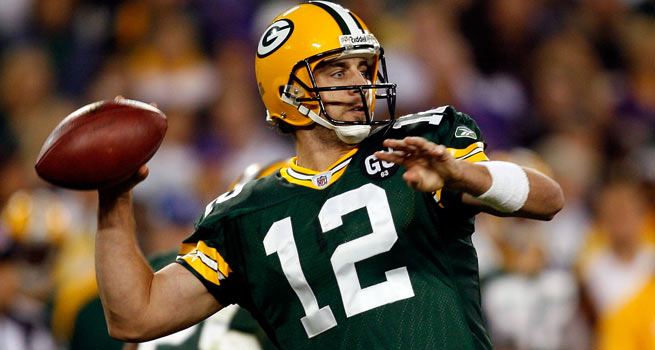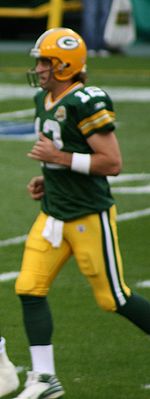Aaron Charles Rodgers (born December 2, 1983 in Chico, California, U.S.) is the starting American football quarterback for the Green Bay Packers of the NFL. Rodgers was drafted in the first round (24th overall) of the 2005 NFL Draft by the Green Bay Packers.[1] Rodgers played college football for the California Golden Bears, where he set several school records, including lowest interception rate at 1.43%.[2]
Rodgers is from Chico in Butte County, California. He attended Pleasant Valley High School in Chico, starting for two years at quarterback and garnering 4,421 passing yards. He set single-game records of 6 touchdowns and 440 all-purpose yards. Rodgers also set a single season record with 2,466 total yards.
Rodgers garnered little interest from Division I programs out of Pleasant Valley with only one offer, that of a walk-on, from the University of Illinois. He declined the Illinois invitation in order to attend Butte College. There Rodgers was discovered by California football head coach Jeff Tedford in 2003 as a freshman, while recruiting Garrett Cross, who attended Chico High School.
College career
2003
As a junior college transfer from Butte Community College in Oroville, California, Rodgers had three years of eligibility. He was named the starting quarterback for the University of California, Berkeley in the fifth game of the 2003 season, against the only team that offered him a division I opportunity out of high school, Illinois. He helped lead the Golden Bears to an 8–6 record, including an upset overtime win over then-No. 3 ranked University of Southern California in his second career start and an Insight Bowl victory against the Virginia Tech Hokies. In 2003, Rodgers tied the school season record for 300 yard games with 5 and set a school record for lowest percentage of passes intercepted at 1.43%.[3]
2004
As a junior, Rodgers led California to the No. 4 regular season ranking. The Bears lost only one regular season game that year, a closely contested and well-played game at #1 Southern California that the Bears lost 23-17. In that game, Rodgers set a school record for consecutive completed passes with 26 and tied an NCAA record with 23 consecutive passes completed in one game. Rodgers set a school single game record for passing completion, completing 85.3% of his passes in that game. Rodgers also holds the school career record for lowest percentage of passes intercepted at 1.95%.[3] Despite these records, the Bears were 1st and goal with 1:47 remaining and the Bears did not score a game-winning touchdown in a game ending sequence that included three incomplete passes and a sack against USC.[4]
After Texas was picked over Cal for a Rose Bowl berth, the Bears earned a spot in the Holiday Bowl, where they lost to Texas Tech, 45-31.[5] After the season, Rodgers entered the 2005 NFL Draft.
College career statistics
| Passing | Rushing | ||||||||||||
|---|---|---|---|---|---|---|---|---|---|---|---|---|---|
| Year | Team | Comp | Att | Pct | Yds | YPA | Td | Int | Rate | Att | Yds | Avg | Td |
| 2003 | Cal | 215 | 349 | 61.6 | 2903 | 8.3 | 19 | 5 | 146.58 | 86 | 210 | 2.4 | 5 |
| 2004 | Cal | 209 | 316 | 66.1 | 2566 | 8.1 | 24 | 8 | 154.35 | 74 | 126 | 1.7 | 3 |
| Totals | 424 | 665 | 63.8 | 5469 | 8.2 | 43 | 13 | 150.27 | 160 | 336 | 2.10 | 8 | |
| Source:[6][7] | |||||||||||||
Awards and honors
- 2003 Honorable mention All-Pac-10[8]
- 2003 Insight Bowl Offensive MVP
- 2004 Cal Co-Offensive MVP[citation needed]
- 2004 First-team All-Pac-10[9]
- 2004 Second-team Academic All-Pac-10[10]
- 2004 Honorable mention All-American by Sports Illustrated[11]
Professional career
Green Bay Packers
Backup seasons (2005–2007)
Rodgers was expected to be selected early in the 2005 NFL Draft and was thought of as the potential number one pick overall. He had posted impressive numbers as a junior with Cal throwing for 2,320 yards with a 67.5 completion rating. He had tied an NCAA record when he completed 23 consecutive passes against the eventual national champions, USC. He threw for 24 touchdowns and only 8 interceptions in his last college season, impressing many NFL scouts. His slip to the 24th choice became one of the biggest stories of the draft, though he was still the second quarterback taken in the draft. In addition to the fact that many teams drafting between second and 22rd positions had positional needs more pressing than quarterback, Rodgers’ relatively short stature (6’2″) may have contributed to his precipitous slide. Rodgers is one of six quarterbacks coached by Jeff Tedford to be drafted in the first round, joining Akili Smith, Trent Dilfer, Joey Harrington, and Kyle Boller.
In August 2005, Rodgers agreed to a reported five-year, $7.7 million deal that included $5.4 million in guaranteed money and had the potential to pay him as much as $24.5 million if all incentives and escalators were met.
Rodgers spent a disappointing 4–12 2005 season as the Packers’ #2 quarterback behind Brett Favre. Rodgers had little playing time during the year, but did see time in a win against the New Orleans Saints and in a loss to the Baltimore Ravens.
When Favre decided to continue his career into the 2006 season, Rodgers was forced to continue in his role as the second quarterback on the depth chart.
On November 19, 2006, Rodgers broke his left foot against the New England Patriots in a 35–0 defeat at home while filling in for an injured Brett Favre and missed the remainder of the 2006 season. Rodgers made a full recovery and was ready for the start of the 2007 season.
Weeks after an emotional interview with NBC’s Andrea Kramer following the team’s season-ending victory at Chicago, Favre announced he would stay with the Packers for the 2007 season, again postponing Rodgers’ hopes of becoming the Green Bay Packers’ starting quarterback. Prior to the 2007 season, rumors surfaced about a potential trade involving Rodgers in which he would be traded to the Oakland Raiders for wide receiver Randy Moss.[12] However, Moss was traded to the New England Patriots during the second day of the 2007 NFL Draft, and Rodgers stayed in Green Bay. The Oakland Raiders received a 4th-round draft choice in the trade for Moss.
Rodgers stepped in when Favre was injured in the second quarter against the Dallas Cowboys on Thursday Night Football on November 29, 2007. Rodgers completed 18 passes for 201 yards, with no interceptions. He also threw his first touchdown pass, but was sacked three times. Rodgers brought the team back from a 17 point deficit to a 3 point deficit, but the Cowboys went on to win 37–27.
Starting seasons
2008
Brett Favre‘s retirement announcement on March 4, 2008, opened up the Packers’ starting quarterback position to Rodgers for the 2008–09 season. Although Favre decided to return from retirement, he was traded to the New York Jets, meaning Rodgers would remain the starter.[13]
With Rodgers making his debut as a starter, the Packers beat the Minnesota Vikings 24–19 at Lambeau Field. This marked the first time since 1992 that a quarterback other than Favre started a regular season game for the Packers. Rodgers ended the game with 178 yards passing and 2 touchdowns (1 passing/1 rushing).[14] In just his second NFL start the following week, Rodgers was voted the FedEx Air award winner after passing for 328 yards and three touchdowns in a win against the Detroit Lions.[15] During the fourth week of the season, Rodgers streak of 157 consecutive pass attempts without an interception ended when he was intercepted by Derrick Brooks of the Tampa Bay Buccaneers. The streak was the third longest in franchise history behind Bart Starr (294) and Brett Favre (163).[16] Rodgers suffered a severe shoulder sprain in the game but continued to start and played well in a win against the Seattle Seahawks two weeks later which to many proved his toughness.[17] Despite early successes, Rodgers had been unable to win a close game during the season despite seven opportunities to do so.[18][19][20] On October 31, 2008, Rodgers signed a six year, $65 million contract extension through the 2014 season.[21][22]
2009
For the opening game of the 2009 regular season, Rodgers recorded his first win in a comeback situation when his team was trailing entering the 4th quarter when he made a fifty yard touchdown pass to wide receiver Greg Jennings with about a minute remaining in the game to help beat the Chicago Bears 21-15.[23] Rodgers was named NFC Offensive Player of the Month for October 2009 when he passed for 988 yards, completed 74.5 percent of his passes, and had a passer rating over 110 for all three games played during the month.[24] After getting off to a mediocre 4-4 start to the season, and a devastating loss to the previously winless Tampa Bay Buccaneers, the team started to heat up. Rodgers led the Packers to five straight wins, in which he threw for 1,324 yards, 9 touchdowns and only 2 interceptions. Rodgers and the Packers won 2 of their last 3 games, finishing the second half of the season with a 7-1 record and an overall 11-5 record; that was good enough to secure a wild card playoff berth and clinch the 5th seed in the playoffs. Rodgers also made history, becoming the first quarterback in NFL history ever to throw for 4,000 yards in both of his first two years as a starter.[25] His passing yardage was good for second all-time in Packers history behind only Lynn Dickey‘s all-time single-season record.[26]
In his first action as a starter in the playoffs against the Arizona Cardinals, Rodgers first pass was intercepted by Dominique Rodgers-Cromartie. However, Rodgers settled down after that miscue to finish the game 28 of 42 for 422 yards with four touchdowns. Despite the big game he had offensively, the Packers lost the game when Rodgers fumbled on the last play of the game in overtime, which was returned by Karlos Dansby for the winning score for a 51-45 Cardinals victory. It was the highest scoring playoff game in NFL history.[27]
Due to his regular season performance, Rodgers earned a trip to his first Pro Bowl as the NFC‘s third Quarterback behind Drew Brees and Brett Favre. However, after Favre dropped out due to injury and Brees was replaced due to his participation in Super Bowl XLIV, Rodgers became the NFC‘s starter for the game. He finished the day 15 of 19 passing with 197 yards and two touchdowns, despite the NFC losing the game.


